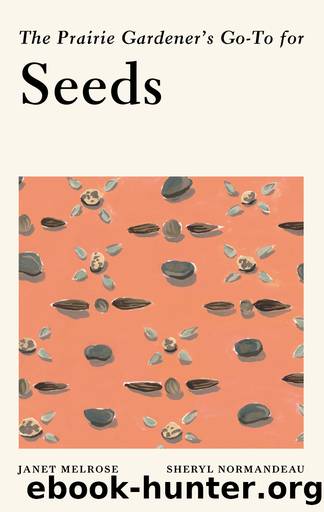The Prairie Gardener's Go-To for Seeds by Janet Melrose

Author:Janet Melrose
Language: eng
Format: epub
Publisher: Touchwood Editions
Published: 2021-10-15T00:00:00+00:00
These pea seeds have been mixed with bacterial inoculant in preparation for planting.
What are âfrost-free daysâ? Why is it important to know about them?
Frost-free days for any given area refers to a statistical average over thirty years of the number of days that will likely not experience temperatures less than 32°F (0°C) at the coldest part of the day. It is not a guarantee that frost will not occurâit could still freeze if the conditions are right. The average number represents that time where plant growth should happen, uninterrupted by frost.
The chances of variation from the last date in spring to the earliest date in fall are around 30 percent, but given the weather extremes that are regularly experienced on the prairies, the number of frost-free days is more a guide than something to rely on. Over the past thirty years, I have seen heavy frost on June 10 and as early as August 25. In an area that now expects to have 112 to 114 frost-free days on average, if both those dates had happened in the same year, which thankfully they did not, there would have been only 74 frost-free days that year!
Topography and geographic location play a big role in whether your garden may or may not escape a late frost or experience an extra early frost, with those at higher elevations likely to have fewer frost-free days. A friend of mine not far out of Calgary but in the foothills and in a river valley has only 47 frost-free days on average! Even microclimates in your own garden can experience variable frost-free days.
Light frost is considered to be between 29 and 32°F (-2 to 0°C), where frost will kill tender plants such as tomatoes.
Moderate frost occurs between 25 and 28°F (-4 to -2°C) and will damage the foliage but not necessarily kill most plants.
Heavy frost occurs below 24°F (-4°C) and will kill or do heavy damage to just about every plant we typically grow.
Rule of thumb: use the number of frost-free days in your area as a guide to what you might be able to grow in any given season. Make wise choices, and then cross your fingers that it will all work out well. But donât be shocked if you are surprised with an unwelcome frost.4âJM
Download
This site does not store any files on its server. We only index and link to content provided by other sites. Please contact the content providers to delete copyright contents if any and email us, we'll remove relevant links or contents immediately.
How to Be a Bawse: A Guide to Conquering Life by Lilly Singh(6693)
Spare by Prince Harry The Duke of Sussex(4195)
Millionaire: The Philanderer, Gambler, and Duelist Who Invented Modern Finance by Janet Gleeson(3568)
Harry Potter 02 & The Chamber Of Secrets (Illustrated) by J.K. Rowling(3292)
Urban Outlaw by Magnus Walker(2950)
The Heroin Diaries by Nikki Sixx(2930)
Never by Ken Follett(2880)
Japanese Design by Patricia J. Graham(2555)
The Club by A.L. Brooks(2359)
The Man Who Died Twice by Richard Osman(2297)
Machine Learning at Scale with H2O by Gregory Keys | David Whiting(2289)
Stacked Decks by The Rotenberg Collection(2270)
Harry Potter and the Deathly Hallows (7) by J.K. Rowling(2215)
Fairy Tale by Stephen King(2069)
Will by Will Smith(2041)
Churchill by Paul Johnson(2011)
Harry Potter and the Prisoner of Azkaban (Book 3) by J. K. Rowling(1967)
The Chimp Paradox by Peters Dr Steve(1861)
The 7 Habits of Highly Effective People: Powerful Lessons in Personal Change (25th Anniversary Edition) by Covey Stephen R(1836)
